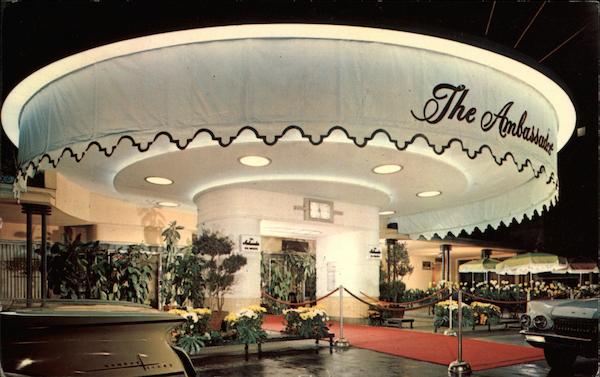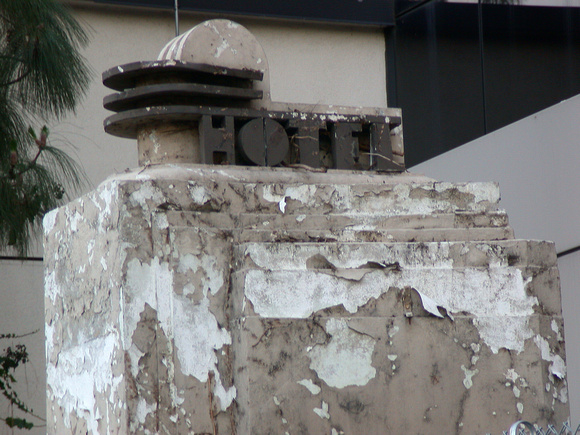 |
| Way Back When: 3400 Wilshire Boulevard |
 |
Even if you knew nothing about the building's past, its many former lives, just the expanse of the lot, the formal elegance of what remained of the structure, you knew there was a reason it stood there so long -- waiting. For what? It wasn't certain at first.
Another piece of L.A. history on the guillotine. I'd grown up seeing this cycle time and again; the past leveled, turned to sand, a new future imagined in its spot. This one felt different though.
The Ambassador Hotel, which once stood imposingly at 3400 Wilshire Boulevard, was built in 1921 designed by Pasadena architect Myron Hunt, and owned and operated by the Schine family for 50 years. The architect, Paul Revere Williams, made the 1949 additions to the property which included renovations to the interior, adjacent private bungalows and a facelift for the famous hotspot, the nightclub known as the Cocoanut Grove.
The hotel attracted dignitaries from around the world, royalty, businessmen, film stars, presidents. It its heyday, it was glamourous and looked something like this:
 But by the early 70s, the hotel had become an anachronism, and even more complicated, an end-of-the-golden dream symbol. Los Angeles' "center" -- always a point of debate -- had been pressing westward for sometime. What cast the most pernicious shadow, however, was that the hotel was the site of then Attorney General Robert F. Kennedy's 1968 assassination. From that moment on the Ambassador would not ever shake the taint. The hotel eventually closed in 1989 and was vacant
until demolished in 2006.
But by the early 70s, the hotel had become an anachronism, and even more complicated, an end-of-the-golden dream symbol. Los Angeles' "center" -- always a point of debate -- had been pressing westward for sometime. What cast the most pernicious shadow, however, was that the hotel was the site of then Attorney General Robert F. Kennedy's 1968 assassination. From that moment on the Ambassador would not ever shake the taint. The hotel eventually closed in 1989 and was vacant
until demolished in 2006.In the hotel's waning years, as a kid, I would find myself on occasion sitting at vast, ciruclar banquet tables at the Ambassador, attending my mother's various "club" luncheons -- fashion shows, educators' meetings and the like. At first I wasn't interested. At all. Listless, I'd tune in and out of the program of speeches and presentations (there was even a woman who would "preform" bird calls) and eat dainty finger sandwiches and sip Shirley Temples. What I most remember is staring at the designs in the ornate ballroom carpet and getting lost in them like a maze.
It wasn't until much later that I began to appreciate the history, the layers of history whispering around me on those Saturday afternoons. I was a voracious reader and on the latter-end of those journeys to the hotel had discovered F. Scott Fitzgerald and was particularly fascinated with his difficult Los Angeles years -- when he'd arrived in Los Angeles to work, not so happily, as a screenwriter. According to lore, Fitzgerald and his wife Zelda stayed for a bit at the Ambassador in one of those Williams designed bungalows. During their stay, the couple met a young actress named Lois Moran. Zelda was miffed at the attention her husband beamed upon the young woman, apparently so enraged after their quarrel that she threw her own clothes into bungalow bathtub and lit them on fire.
 By the 80s, the Ambassador resembled something that had been put into storage for too long. In the closed-off floors and rooms, it gave off that odor too. It had also acquired a deeper patina of sadness. Strangely though, my high school prom was held here, at the Grove, that by this time had been renovated once more and had a strange sort of disco-70s-glass-and-mylar-red-carpet feel to it. It was like a variety show set, you expected to see entertainers of that vintage, say Cher or Sammy Davis Jr., walk out on stage. For a time, they did. I opted out of going and instead wandered out with a tribe of friends to the beach that night -- a sort of anti-prom nonevent. It was a choice I didn't regret for years, until it looked as if the down-at-the-heels building would come down for sure.
By the 80s, the Ambassador resembled something that had been put into storage for too long. In the closed-off floors and rooms, it gave off that odor too. It had also acquired a deeper patina of sadness. Strangely though, my high school prom was held here, at the Grove, that by this time had been renovated once more and had a strange sort of disco-70s-glass-and-mylar-red-carpet feel to it. It was like a variety show set, you expected to see entertainers of that vintage, say Cher or Sammy Davis Jr., walk out on stage. For a time, they did. I opted out of going and instead wandered out with a tribe of friends to the beach that night -- a sort of anti-prom nonevent. It was a choice I didn't regret for years, until it looked as if the down-at-the-heels building would come down for sure. During the early 90s, the owners opened the grounds and invited visitors to come in and pay their last respects. Although, the property had been used for movie and television shoots, the general public hadn't been allowed on the grounds for years. By this time, I was working as a journalist, so I, along with a photographer friend of mine, descended on the property to take photos and interview people who lingered in the musty hallways or had a grilled cheese at the soon-to-be-shuttered coffee shop. Some of the visitors had married there, some had honeymooned, others, like me, had spent Saturdays with their moms at long Saturday luncheons. After awhile, the stories began to feel like one large public collage, linking together the hotel's story past and present. In a few more months, a public sale of the contents was held: I purchased salad plates and a sliver casserole dish even stationery and cocktail napkins embossed with the Ambassador logo.
After a decades-long, bitter fight between residents, conservationists and the school board, the Los Angeles Unified School District erected a state of the art educational complex on the old site. As a tribute to the fallen politician, it's been named, The Robert F. Kennedy Community Schools.
In recent years, I haven't been able to drive past the building -- or where the building should be. Even growing up where I know things very seldom stay the same, I knew seeing this huge block of memory vanished would break my heart.
One of the last evenings I set foot inside the hotel, when it was still a going concern, some other reporter friends of mine decided to meet up after work. We were looking for a place that wasn't a scene. The Ambassador hadn't fit that description for more than four decades. Even still, there was an elegant lounge off the lobby, that opened out into a vibrant rose garden; The Palm Bar, it was called. By then, the mix of clientele reflected the neighborhood's evolved new mix -- Korean businessmen, Silver Lake night crawlers and of course, some remnants from the old days -- couples who used to live just down the street in one of the high rise hotels topped with those elegant signs that, after dusk, spelled out each building's name in cool neon script. They ordered their Manhattans and Martinis. On demand, they happily regaled us with stories about the Academy Award events once held at the Grove, the dignitaries who once stayed there, and too, their memories of RFK's last night on the campaign trail.
I sat with my friends, near open doors that framed the fragrant garden and for once, instead of trying to time-travel, instead of chasing antique ghosts, I made note of the soon-to-be vanished details before us -- the image of us arranged in those high-backed chairs, the rise and fall of excited voices telling and listening to Los Angeles stories, the sharp scent of the night-blooms on a eve-of-Spring night, I was aware that I would be both making and then embroidering memory. I knew, this little moment too would be gone soon enough -- and yet until all of us ourselves were ghosts -- not the memory of it.
(For an detailed visual past to present timeline of the site in recent years you can click here.)
 |
| Today: 3400 Wilshire Blvd: Robert F. Kennedy Community Schools |
-- L.G

When I read the paragraph about the public's last chance to bid goodbyes to the hotel - it really made me think: what is our attachment to buildings? or in better words...why are we attached to places? I've always felt that way about certain places from my past. One place can mean something different to each person. What is it that we assign to these locations that are no more than brick and wood? I also like how your post made me think of how being in a space can bring the past to life in the imagination - walking ghosts.
ReplyDeleteIt's funny. I agree with you. I have a friend, whom whenever she moves, says goodbye out loud to her old place. I hadn't realized how much emotion one could attach to the inanimate -- and inanimate object that you can't hold in your hands. Memories do have triggers and I still see the entrance of the hotel to this day, the red carpet in front, the brass doors and I still feel this sense of feel this sense connecting with the past -- a former Los Angeles, one before my time. It's so rare to have those feelings here sadly. I miss that elegant sprawl of a building, even in its down-at-the-heels days. Thanks for your note.
ReplyDelete